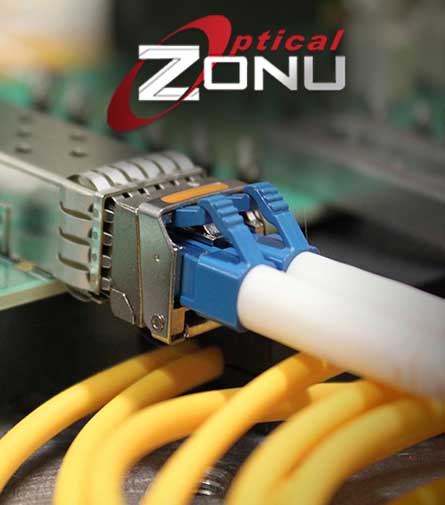 Ron Stark, VP of Sales and Marketing,Optical Zonu
Ron Stark, VP of Sales and Marketing,Optical ZonuWhat is the Micro-OTDR? Accurate fault location capability SFP
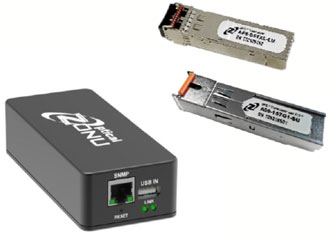
Features
• Immediate localization of an optical fiber break, cut or failure
• Based on Industry standards, SFP/SFP+ data transceivers are deployed in all Switch, Router, Media Converter equipment and more.
• SFP/SFP+ transceivers are industry standard configurations of fiber optic digital data transport devices
• Direct functional replacement with the additional capability to instantly detect, locate (within few meters) an optical fiber break or failure
• Report optical fiber faults network operations center - utilizing almost any host switch
• Patented
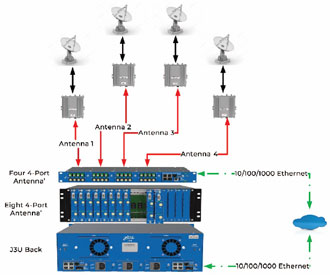
BENEFITS (in addition to the standard data transport capabilities)
• Made in the USA
• Dramatically reduces the Detection Time (length of time to find the break) anywhere from 2 hours to 2 weeks
• Reduce the Mean-Time-to-Recovery (MTTR) from an optical fiber fault.
• Significant cost savings for the Communications Service Provider (CSP),
• Reduced OpEX due to instant location capabilities
• Improved service levels, delivering a real competitive advantage
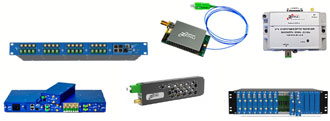
Who do we compete with?
• There are SFP competitors (see list below)
• However, there are no Micro-OTDR competitors.
• Below are functional, but not true competitors
• Remote Fiber Test System (RFTS) - large, expensive, requires trained technician and must be centralized to monitor multiple fibers, takes longer to locate break (detection time)
o NTest, inc, Minnesota USA
• Full Function OTDR - not as large as but still big, expensive, requires trained technician takes longer to locate break
o Anritsu, Japan
o EXFO, Canada
o Viavi, San Jose, USA
• Handheld OTDR – smaller but expensive, requires trained technician in field searching for break
o EXFO, Canada
o Viavi, San Jose, USA
o AFL, Duncan South Carolina
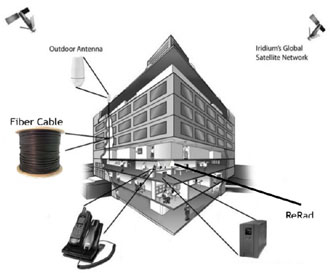
Fiber optic transport solutions for Satcom communications
Satellite networks, commercial and military, all require a simple replacement of coaxial cables (and waveguides) by optical fiber for between the Antenna(s) and Network Operation Center (NOC). Coaxial cables are limited to ~300 feet they are rigid and can be difficult to install.
Features
• Offering flexible/quick deployment of military frontline command centers or any installation that needs to be placed far away from the antenna.
• Addresses the transport of the 10 MHz / L-Band with high fidelity phase noise performance
• Offers an outdoor enclosure
• Full support for Antenna LNB control
• Full Monitoring & Control, GbE as an option
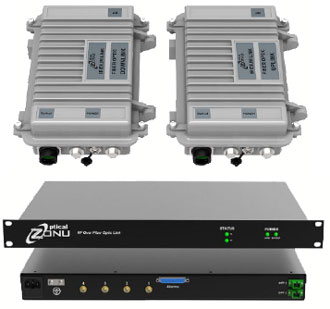
Benefits
• Made in the USA
• Using Fiber Optics for connectivity allows installation to utilize the most convenient route.
• Compact, highly reliable easy-to-install & maintain,
• cost-effective RFoF link for distances from 100m - to >10km with Ethernet and supervision.
• The savings when compared to structural support for coaxial runs is significant
Who do we compete with?
• Evertz, Canada
• Vialite/PPM, UK
• Foxcomm, Israel
• ETL, UK
• Emcore, Alhambra, CA
Unique fiber optic coverage solutions for Satellite Phone: for iridium, Globalstar, etc.
Satellite Phone networks were designed to offer voice communication worldwide via direct link between the user handset and the satellite constellation that supports the service. Indoors, without a direct line of sight to the sky, the service is hindered by walls, roofs and other structures.
Features
• The OZC family of product allows fixed equipment (modems) to work indoors with fixed or wireless connectivity, as well as providing coverage to controlled indoor area(s) where anyone who subscribes to the service can use his/her handset.
• Communicate via the satellite network while in a building, underground, or in a tunnel.
Benefits
• Made in the USA
• With our solutions, usage of a Satellite phone can be expanded to include data services (military and civil), conference calls and tracking cargo and sensitive equipment.
• Based on market proven RF over Fiber product family
• Adaptable and customizable
Who do we compete with?
The following companies can develop such a product BUT HAVE NOT. As of today OZC is the only solution supplier for fiber based indoor coverage.
• Evertz, Canada
• Vialite/PPM, UK
• Foxcomm, Israel
• RF Optics, Israel
• ETL, UK
• Emcore, Alhambra, CA
Outdoors:
Indoors: same as outdoors OR:
 Fiber optic transport solutions for microwave communications
Fiber optic transport solutions for microwave communications
Microwave signals are propagated over waveguide or coaxial cables to and from antennas for radar, delay lines, Common Data Link (CDL), Satcom, and many other related wireless systems. These signals are in different bands C, X, Ku, DBS and Ka-bands and pure wideband applications.
Optical Zonu offers full families of Microwave RF transport over fiber
Features
• Transport over fiber allows the connectivity path to take the most convenient route and not the route dictated by bulky coaxial cabling.
• Our MW products provide compact, highly reliable, easy-to-install & maintain, cost-effective RFoF links, for distances from 100m to ~50km with Ethernet and SNMP (supervision) connectivity to boot.
• Waveguide and Coaxial cable are limited to ~ 300 feet
• Our products support frequencies from a few KHz and range up to >40GHz
• Any customer application – signal transport, delay lines, phased array etc. can be answered based on a standard OZC product family.
Benefits
• Made in the USA
• Offering Microwave Antennae Distribution, Broadband Delay Lines, Frequency Distribution Systems, Radar System Calibration, Remote Antennae Location, Multi-Band Satcomm
• Highly customizable
• Also supports Avionics
• Compact form factor
• RF Frequency up to 40 GHz supported
• IP 68 rated
Who do we compete with?
• Emcore, Alhambra, CA
• Linear Photonics, Hamilton, NJ
• RFMW Systems, Israel
• Microwave Photonic Systems, Westchester, PA
GPS Fiber Transport – Timing Solutions
Cellular wireless networks, public safety wireless networks and data networks, all require highly precise timing signals to synchronize data transfers and handoffs. The faster the network, the more precise the timing signals must be.
The most accurate and ubiquitously available timing reference is from the Global Navigation Satellite System (GNSS), aka GPS (Global Positioning System). Many networks utilize timing servers at their central hubs. These servers need a connection to a GPS antenna to generate the timing signals and distribute to connected devices. In very high-speed networks, this approach is limited to nearby devices.
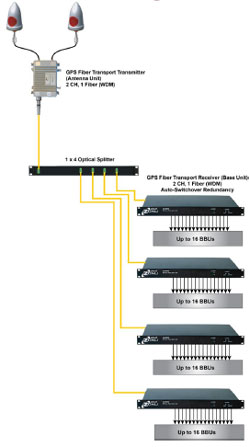 The simplest, most reliable and most accurate approach is to provide direct GPS RF connections to all devices that are configured to accept it. Optical Zonu’s GPS Fiber Transport is optimized to provide connectivity for both single connection and distribution to over one hundred connections.
The simplest, most reliable and most accurate approach is to provide direct GPS RF connections to all devices that are configured to accept it. Optical Zonu’s GPS Fiber Transport is optimized to provide connectivity for both single connection and distribution to over one hundred connections.
Features
• Compact, Antenna Unit – can be mounted indoors or outdoors
• Rack mounted fiber optic Base Unit recovers the GPS RF signal with up to 16 GPS connections
• The fiber from the Antenna Unit can be optically split up to 8 ways providing up to 8 x 16 = 128 connections from a single Antenna unit
• Available with auto-redundancy switchover to a 2nd GPS antenna path for added reliability (within the same compact size)
• Patented optical alarm reporting – eliminates need for a separate computer monitoring set up
• Low profile design with lightweight fiber distribution, the only solution permitted in many switching centers
• NEBS Level 3 permits installation in Central Offices
• Only solution approved by all 4 US mobile wireless carriers
• Can be simplified for simple situations.
BENEFITS
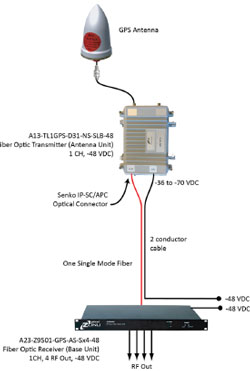 • Made in the USA
• Made in the USA
• Simple installation and integration into a system Network Management System (NMS), minimizes time and cost of integration
• Compact Antenna Unit and low-profile Base Unit minimizes space needed
• Auto-redundancy ensures highest reliability in crucial installations
• RF-over-Fiber design ensures lowest cost, highest reliability
Who do we compete with?
• Intellibs – approved by Verizon only. Large units, complex set up a computer monitoring required. More expensive.
• Vialite – UK based. Not approved by US carriers.
• GPS Source – active coaxial solution. Cost-effective for small sites when GPS antenna is close to the base station gear. Awkward for larger sites where long runs of ½ inch coaxial cable is needed. Not permitted in many switching centers and central offices
• PTP Timing – PTP timing servers themselves require a GPS connection but the timing signal itself can be routed to many devices. Subject to errors over long distances.
 Unique fiber optic transport solutions for Wireless/Cellular communications: Cellular BaseStation(s) to/from DAS – universal transport
Unique fiber optic transport solutions for Wireless/Cellular communications: Cellular BaseStation(s) to/from DAS – universal transport
What is ZONUConnectTM?
One of standard solutions to providing uniform mobile wireless coverage in buildings is to deploy a Distributed Antenna System (DAS). For smaller sites, this can be a passive system using coaxial cables and splitters connecting to antennas distributed throughout the building. For larger sites, an active DAS is deployed. These systems convert the mobile wireless RF signals to optical and distributes these signals over optical fiber to antenna units that convert the optical signal back to RF.
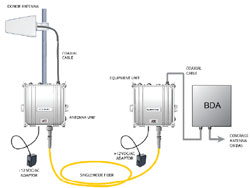 It is often the case that, because of space limitations or access, the carriers that want to connect to a DAS may have to locate their base station radios off-site. There are several ways to connect to a remote DAS but, in most cases, ZONUConnectTM provides the most efficient solution in terms of cost, rack space and fiber count. It also gives the carrier full access to his equipment and minimizes maintenance problems.
It is often the case that, because of space limitations or access, the carriers that want to connect to a DAS may have to locate their base station radios off-site. There are several ways to connect to a remote DAS but, in most cases, ZONUConnectTM provides the most efficient solution in terms of cost, rack space and fiber count. It also gives the carrier full access to his equipment and minimizes maintenance problems.
Features
• Selection of interfaces to connect to any base station configuration and any combination of services
• Scalable for any number of sectors
• Broadband RF-over-Fiber using CWDM
• Distances from 300ft to 12 miles
• Computer-controlled local and remote set up, commissioning along with SNMP remote monitoring
• Connects to any DAS
BENEFITS
• Made in the USA
• Minimum rack space – DAS sites are having increasing shortage of rack space. Carrier’s must also pay for space used
• Common connectivity from central location to multiple DAS sites simplifies maintenance and lowers cost
• Minimum fiber count – availability of dark fiber is often a problem. Cost of leasing dark fiber is minimized
• Guarantees full access – CPRI to Remote Radio approach leaves part of the carriers’ base station equipment on the property of the 3rd party DAS owner with no or limited access
• Ensures maintenance demarcation point for 3rd party DAS, all DAS-specific remote connectivity solutions require that part of the DAS be located off-site at the carriers’ property. ZONUConnectTM ensures that 3rd party DAS equipment is only on the property of the 3rd party
Who do we compete with?
• Teko (JMA) – Teko has a DWDM solution that uses more rack space and is considerably more expensive
• Corning – the CorningOne solution is optimized for use with the CorningOne DAS. It is more expensive that ZONUConnectTM, uses more fiber, and requires that part of the DAS headend be installed off-site on the customer’s property
• CPRI (Common Public Radio Interface) to Remote Radio Head - digital single channel transport. The base station usually consists of two components – the Base Band Unit (BBU) and the Remote Radio Head (RRH). The BBU handles the digital processing and backhaul link to the network hub. The RRH is the RF front end and connects to the BBU via a fiber optic CPRI link. Deploying the RRHs at the DAS headend leaves part of the base station at a 3rd party property with no access. It also using more space, more fiber and more power than ZONUConnectTM which the customer pays significantly higher price.
WE ALSO OFFER AN ANTENNA EXTENDER family that provides simple solutions and stand-alone DAS for small deployments.
• RF Optics, Israel
• ETL, UK
• Emcore, Alhambra, CA
Outdoors:
Indoors: same as outdoors OR:
 Fiber optic transport solutions for microwave communications
Fiber optic transport solutions for microwave communicationsMicrowave signals are propagated over waveguide or coaxial cables to and from antennas for radar, delay lines, Common Data Link (CDL), Satcom, and many other related wireless systems. These signals are in different bands C, X, Ku, DBS and Ka-bands and pure wideband applications.
Optical Zonu offers full families of Microwave RF transport over fiber
Features
• Transport over fiber allows the connectivity path to take the most convenient route and not the route dictated by bulky coaxial cabling.
• Our MW products provide compact, highly reliable, easy-to-install & maintain, cost-effective RFoF links, for distances from 100m to ~50km with Ethernet and SNMP (supervision) connectivity to boot.
• Waveguide and Coaxial cable are limited to ~ 300 feet
• Our products support frequencies from a few KHz and range up to >40GHz
• Any customer application – signal transport, delay lines, phased array etc. can be answered based on a standard OZC product family.
Benefits
• Made in the USA
• Offering Microwave Antennae Distribution, Broadband Delay Lines, Frequency Distribution Systems, Radar System Calibration, Remote Antennae Location, Multi-Band Satcomm
• Highly customizable
• Also supports Avionics
• Compact form factor
• RF Frequency up to 40 GHz supported
• IP 68 rated
Who do we compete with?
• Emcore, Alhambra, CA
• Linear Photonics, Hamilton, NJ
• RFMW Systems, Israel
• Microwave Photonic Systems, Westchester, PA
GPS Fiber Transport – Timing Solutions
Cellular wireless networks, public safety wireless networks and data networks, all require highly precise timing signals to synchronize data transfers and handoffs. The faster the network, the more precise the timing signals must be.
The most accurate and ubiquitously available timing reference is from the Global Navigation Satellite System (GNSS), aka GPS (Global Positioning System). Many networks utilize timing servers at their central hubs. These servers need a connection to a GPS antenna to generate the timing signals and distribute to connected devices. In very high-speed networks, this approach is limited to nearby devices.
 The simplest, most reliable and most accurate approach is to provide direct GPS RF connections to all devices that are configured to accept it. Optical Zonu’s GPS Fiber Transport is optimized to provide connectivity for both single connection and distribution to over one hundred connections.
The simplest, most reliable and most accurate approach is to provide direct GPS RF connections to all devices that are configured to accept it. Optical Zonu’s GPS Fiber Transport is optimized to provide connectivity for both single connection and distribution to over one hundred connections.Features
• Compact, Antenna Unit – can be mounted indoors or outdoors
• Rack mounted fiber optic Base Unit recovers the GPS RF signal with up to 16 GPS connections
• The fiber from the Antenna Unit can be optically split up to 8 ways providing up to 8 x 16 = 128 connections from a single Antenna unit
• Available with auto-redundancy switchover to a 2nd GPS antenna path for added reliability (within the same compact size)
• Patented optical alarm reporting – eliminates need for a separate computer monitoring set up
• Low profile design with lightweight fiber distribution, the only solution permitted in many switching centers
• NEBS Level 3 permits installation in Central Offices
• Only solution approved by all 4 US mobile wireless carriers
• Can be simplified for simple situations.
BENEFITS
 • Made in the USA
• Made in the USA• Simple installation and integration into a system Network Management System (NMS), minimizes time and cost of integration
• Compact Antenna Unit and low-profile Base Unit minimizes space needed
• Auto-redundancy ensures highest reliability in crucial installations
• RF-over-Fiber design ensures lowest cost, highest reliability
Who do we compete with?
• Intellibs – approved by Verizon only. Large units, complex set up a computer monitoring required. More expensive.
• Vialite – UK based. Not approved by US carriers.
• GPS Source – active coaxial solution. Cost-effective for small sites when GPS antenna is close to the base station gear. Awkward for larger sites where long runs of ½ inch coaxial cable is needed. Not permitted in many switching centers and central offices
• PTP Timing – PTP timing servers themselves require a GPS connection but the timing signal itself can be routed to many devices. Subject to errors over long distances.
 Unique fiber optic transport solutions for Wireless/Cellular communications: Cellular BaseStation(s) to/from DAS – universal transport
Unique fiber optic transport solutions for Wireless/Cellular communications: Cellular BaseStation(s) to/from DAS – universal transportWhat is ZONUConnectTM?
One of standard solutions to providing uniform mobile wireless coverage in buildings is to deploy a Distributed Antenna System (DAS). For smaller sites, this can be a passive system using coaxial cables and splitters connecting to antennas distributed throughout the building. For larger sites, an active DAS is deployed. These systems convert the mobile wireless RF signals to optical and distributes these signals over optical fiber to antenna units that convert the optical signal back to RF.
 It is often the case that, because of space limitations or access, the carriers that want to connect to a DAS may have to locate their base station radios off-site. There are several ways to connect to a remote DAS but, in most cases, ZONUConnectTM provides the most efficient solution in terms of cost, rack space and fiber count. It also gives the carrier full access to his equipment and minimizes maintenance problems.
It is often the case that, because of space limitations or access, the carriers that want to connect to a DAS may have to locate their base station radios off-site. There are several ways to connect to a remote DAS but, in most cases, ZONUConnectTM provides the most efficient solution in terms of cost, rack space and fiber count. It also gives the carrier full access to his equipment and minimizes maintenance problems.Features
• Selection of interfaces to connect to any base station configuration and any combination of services
• Scalable for any number of sectors
• Broadband RF-over-Fiber using CWDM
• Distances from 300ft to 12 miles
• Computer-controlled local and remote set up, commissioning along with SNMP remote monitoring
• Connects to any DAS
BENEFITS
• Made in the USA
• Minimum rack space – DAS sites are having increasing shortage of rack space. Carrier’s must also pay for space used
• Common connectivity from central location to multiple DAS sites simplifies maintenance and lowers cost
• Minimum fiber count – availability of dark fiber is often a problem. Cost of leasing dark fiber is minimized
• Guarantees full access – CPRI to Remote Radio approach leaves part of the carriers’ base station equipment on the property of the 3rd party DAS owner with no or limited access
• Ensures maintenance demarcation point for 3rd party DAS, all DAS-specific remote connectivity solutions require that part of the DAS be located off-site at the carriers’ property. ZONUConnectTM ensures that 3rd party DAS equipment is only on the property of the 3rd party
Who do we compete with?
• Teko (JMA) – Teko has a DWDM solution that uses more rack space and is considerably more expensive
• Corning – the CorningOne solution is optimized for use with the CorningOne DAS. It is more expensive that ZONUConnectTM, uses more fiber, and requires that part of the DAS headend be installed off-site on the customer’s property
• CPRI (Common Public Radio Interface) to Remote Radio Head - digital single channel transport. The base station usually consists of two components – the Base Band Unit (BBU) and the Remote Radio Head (RRH). The BBU handles the digital processing and backhaul link to the network hub. The RRH is the RF front end and connects to the BBU via a fiber optic CPRI link. Deploying the RRHs at the DAS headend leaves part of the base station at a 3rd party property with no access. It also using more space, more fiber and more power than ZONUConnectTM which the customer pays significantly higher price.
WE ALSO OFFER AN ANTENNA EXTENDER family that provides simple solutions and stand-alone DAS for small deployments.
|
Share this Article:
Tweet
|
Top





